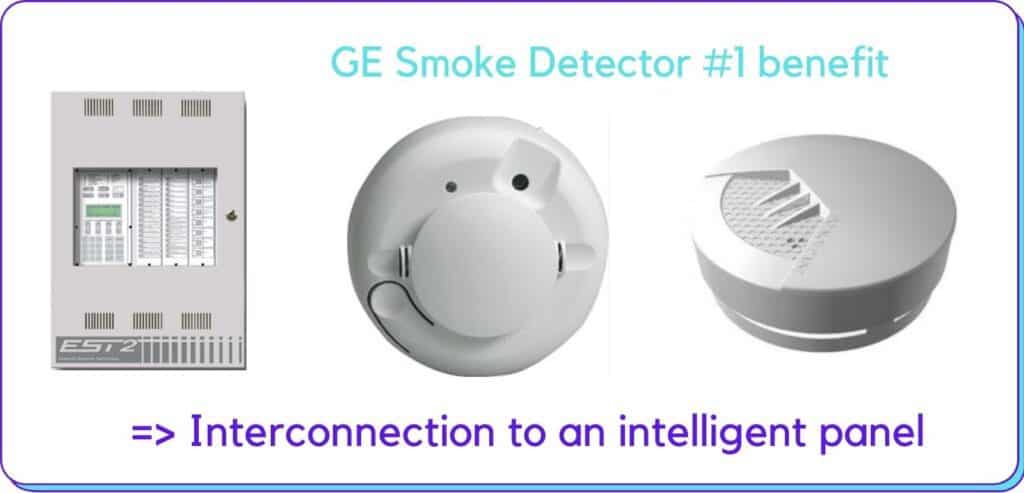Do you want to safeguard your home and family against fires? Invest in a smoke detector. But, what if you don’t know which brand of a smoke detector to go for?

Whether you want to secure your residence against smoldering or flaming fires, the GE smoke detector is a great option to consider.
In this article, we discuss the specifics of the GE wireless smoke detector, the procedure for installation, and much more. So read on.
Contents
Features of GE ESL Smoke Detectors
The GE smoke detectors are available in two designs for different applications; the stand-alone and supervised wireless types.
The supervised model, which is our focus, also has subtypes depending on the intended place of use.
Supervised wireless models for residential areas are compatible with GE Interlogix control panels while those for commercial buildings work with Advent panels only.
Remember, we are not discussing recalled GE smoke detectors in this article.
But a panel is not a must-have for the smoke-detector configuration.
For instance, you can configure and program your GE wireless smoke detector in the Composer without a panel. But you have to use a Card Access Sensor Bridge and the corresponding DriveWorks driver.
If you want to utilize the same Navigator display features with the usual icons one would obtain through panel identification and programming, bind your wireless sensor to any proxy.
This method of configuration does not require any advanced knowledge on security systems or panel programming! Consequently, this makes the initialization of the detectors much easier.
But the benefits of installing a GE smoke detector are even more for those using GE security systems. The device will relay security sensor information to the system. This is an addition to providing a home automation lifestyle to the GE system without any installation interference.

The GE Interlogix Wireless Smoke Detector is self-diagnostic. On top of this, it integrates a wireless Learn Mode sensor transmitter of 319.5 MHz.
The main features of the TX series detectors include a field-replaceable optical chamber, integrated temperature-rise sensor, automated drift compensator, low-battery annunciator, and a self-contained Temp 3 sounder.
Most importantly, it uses photoelectric technology to detect smoke particles and consequently send an alarm along with important circumstance info to the control panel.
Besides, it comes with a status-sensitive LED and mounting base tamper which is essential in the relaying of trouble conditions.
As a battery-operated detector, GE wireless smoke sensor package includes 3-volt long-life lithium batteries.
What signal outputs can a GE ESL Smoke Detector transmit?
Apart from the fire alarms, this detector can produce signals indicating low battery, tamper, and trouble conditions.
During test and supervisory events, a signal will be conveyed too.
GE Smoke Detector Manual for Programming
Before you begin enjoying the safety provided by a smoke detector, you need to program it. Here are the steps you need to follow:
- Turn the unit 15 degrees anticlockwise to disengage it from the mounting base.
- Now lift off the battery cover by sliding it away from the unit and insert the lithium batteries included in the package. Ensure you observe polarity.
- After inserting the cells, replace the mounting base. Put the unit with the alignment tab position corresponding to the position of the alignment arrow on the tamper base. Then turn the unit 15 degrees clockwise. You hear a snapping sound when the unit fits into place.
- Now move to the panel and set installer programming mode (you can refer to panel installation manual for more directions). Scroll to the enrolling/learning sensors section.
- When a ‘learn/ enroll sensor’ prompt appears on the panel display, disconnect the unit from the base to trip the tamper.
- Lastly, reattach the unit to the base and exit the installer programming mode on the panel.
After programming your GE Smoke Detector, you need to verify the integrity of RF communication between the unit and the panel.
You perform the verification before you mount the detector at your preferred site. With the help of your panel’s installation instructions, turn to Dealer Sensor Test Mode on the panel as the initial step.
Secondly, take the detector to the designated mounting point and long-press the ‘Test’ button for about 4 seconds. The unit should transmit a test signal to the system and produce an appropriate alarm response.
Finally, exit the Dealer Sensor Test Mode and mount your GE Wireless Smoke Detector once the corroboration is over.
Where do I mount my GE Interlogix Wireless Smoke Detector?
Installation of this smoke detector should be per the standard protocols which include recommendations on mounting sites.
For existing residential houses, fix the smoke alarm between bedrooms. This will help keep your family safe in case of a fire at night.
If it is a story building, each floor needs to have an alarm installed without excluding the basement. Specifically, the alarm should be mounted in the living room along the stairway.
Smoke alarms installation in a new building is similar to that of an existing one. The only exception is the additional alarms fitted in all bedrooms.
Notable, areas separated by a wall and a door from those with a smoke alarm are riskier. The simple reason being; a fire won’t be detected on time.
It is, therefore, beneficial to fix more GE smoke detectors in such places. For instance hallways, dining room, and utility room.
However, do not install these devices in kitchens, garages, or attics. It does not matter whether they are complete or unfinished. The conditions in these areas often result in improper functioning of the detectors.
When should I perform a smoke test on my GE Smoke Detector?
After mounting your smoke detector, you need to perform smoke and sensor tests to ensure your system is functioning optimally.
The sensor drill is done weekly to test for the integrity of communication between the sensor and the receiver. In most cases the receiver is commonly referred to as the panel.
Smoke test, on the other hand, is carried annually and it verifies whether the unit activates upon detecting smoke; transmitting the signal as required, and producing appropriate alarm response.
Conclusion
A GE smoke detector is essential in protecting your home and family against fire emergencies. However, its condition must be regularly checked to ensure it is working optimally.
Programming, sensor testing, and appropriate mounting are some of the ways of promoting higher efficiency of GE wireless smoke detectors.